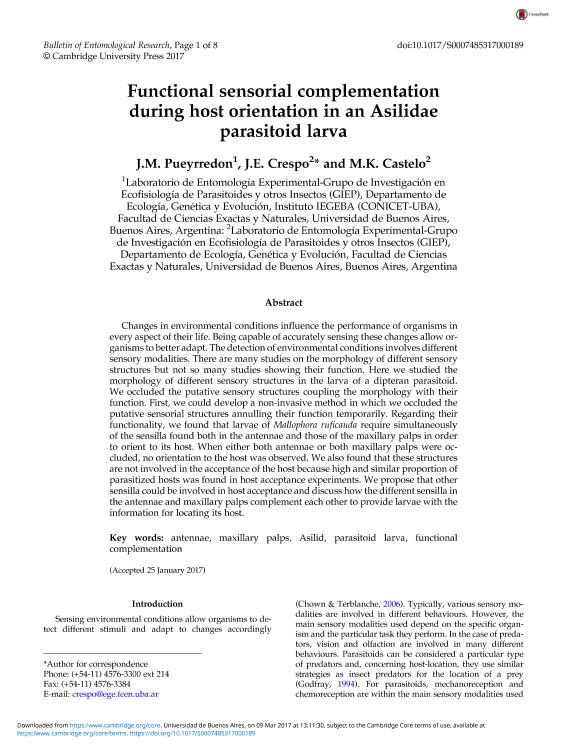Artículo
Functional sensorial complementation during host orientation in an Asilidae parasitoid larva
Fecha de publicación:
03/2017
Editorial:
Cambridge University Press
Revista:
Bulletin of Entomological Research
ISSN:
0007-4853
Idioma:
Inglés
Tipo de recurso:
Artículo publicado
Clasificación temática:
Resumen
Changes in environmental conditions influence the performance of organisms in every aspect of their life. Being capable of accurately sensing these changes allow organisms to better adapt. The detection of environmental conditions involves different sensory modalities. There are many studies on the morphology of different sensory structures but not so many studies showing their function. Here we studied the morphology of different sensory structures in the larva of a dipteran parasitoid. We occluded the putative sensory structures coupling the morphology with their function. First, we could develop a non-invasive method in which we occluded the putative sensorial structures annulling their function temporarily. Regarding their functionality, we found that larvae of Mallophora ruficauda require simultaneously of the sensilla found both in the antennae and those of the maxillary palps in order to orient to its host. When either both antennae or both maxillary palps were occluded, no orientation to the host was observed. We also found that these structures are not involved in the acceptance of the host because high and similar proportion of parasitized hosts was found in host acceptance experiments. We propose that other sensilla could be involved in host acceptance and discuss how the different sensilla in the antennae and maxillary palps complement each other to provide larvae with the information for locating its host.
Palabras clave:
Antennae
,
Asilid
,
Functional Complementation
,
Maxillary Palps
,
Parasitoid Larva
Archivos asociados
Licencia
Identificadores
Colecciones
Articulos(IEGEBA)
Articulos de INSTITUTO DE ECOLOGIA, GENETICA Y EVOLUCION DE BS. AS
Articulos de INSTITUTO DE ECOLOGIA, GENETICA Y EVOLUCION DE BS. AS
Citación
Pueyrredon, Juan Maria; Crespo, José Emilio; Castelo, Marcela Karina; Functional sensorial complementation during host orientation in an Asilidae parasitoid larva; Cambridge University Press; Bulletin of Entomological Research; 107; 5; 3-2017; 1-8
Compartir
Altmétricas




